Is this the M4 MacBook Air killer?

At a café the other day, I witnessed an interesting reaction—excitement and desire for a laptop—something that is rare these days. It took me by surprise. And when you see the Asus ZenBook A14 for the first time, I bet it will grab your attention just as it did mine.
The ZenBook A14 isn’t an experimental device. It’s a traditional notebook that’s so light (it almost feels weightless) that it functions like a smartphone with long battery life. It’s a general-purpose laptop with features that cater to the needs of average users—especially connected and mobile users who have always wanted these qualities in a Windows device but never quite found them.
ASUS Zenbook A14 has been made with a new material called “Ceraluminum”. Image credit: Anuj Bhatia/Indian Express)
I know the question everyone is asking: Is it worth the money, and is this the right laptop for me? After all, the ZenBook A14 arrives at a time when the new M4 MacBook Air is also hitting the market. I spent a week with the Asus ZenBook A14, and I have a few thoughts.
What: Asus ZenBook A14 (14-inch 1,920×1,200 OLED, Qualcomm Snapdragon X X1-26-100 CPU, 16GB RAM, 512GB of SSD)|Price: Starts at Rs 99,990
‘So lightweight it feels there’s nothing in the bag’
That was exactly what I thought when I took the Delhi Metro and travelled from one part of the city to another, standing for the entire hour-long journey. I travel a lot for work, so I naturally have a fascination for computers that I can take anywhere.
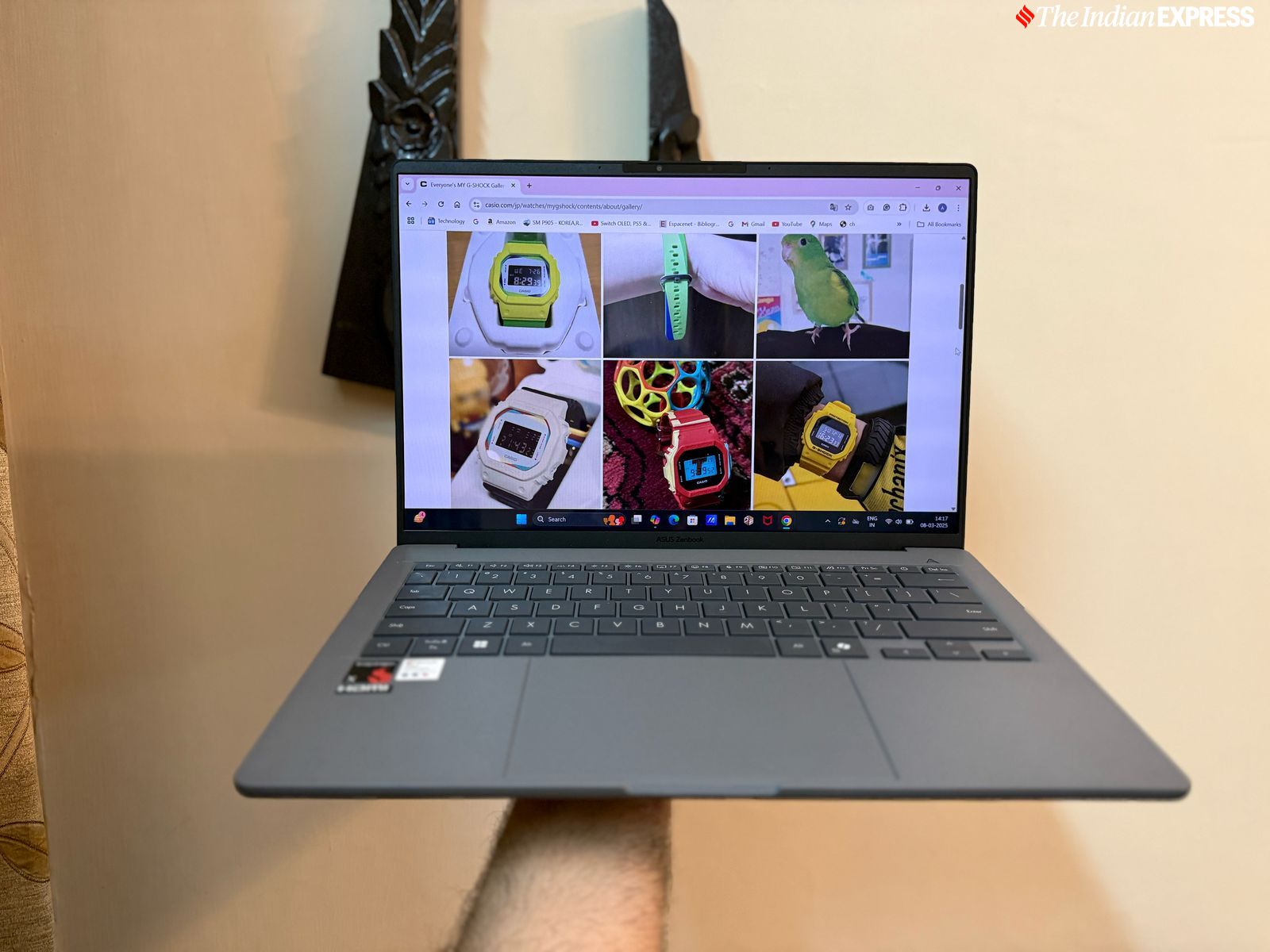 The ZenBook A14 is crazy light. (Image credit: Anuj Bhatia/Indian Express)
The ZenBook A14 is crazy light. (Image credit: Anuj Bhatia/Indian Express)
Weighing just 0.98 kg and measuring only 1.34 cm (0.53 in) thick, the ZenBook A14 is one of the most ultraportable notebooks on the market today. And while the numbers look impressive on paper, it’s not until you hold the ZenBook A14 in your hands that you truly appreciate its incredible design and how thin and light it is.
It’s not a small device, though—it still has a 14-inch screen, making it a real laptop rather than a mini notebook. Sure, the Apple MacBook Air (for reference, the 13-inch model weighs 1.22 kg) is thin and light, but the ZenBook A14 feels even more lightweight—so much so that, at times, I forget I have a laptop in my bag. And that wouldn’t be an understatement.
Story continues below this ad
Even the charger that comes with the ZenBook A14 is compact—it’s the size of a smartphone power brick. Travelling with the ZenBook A14 will be light, leaving more space in your bag for other essential items.
It seems that Asus had to use a different type of material to shed a few grams and make the ZenBook A14 so light. It features a Ceraluminum enclosure, a material that combines aluminum and ceramic (frankly, I had never heard of it before). This is a proprietary material Asus developed specifically for this laptop. Not only does it make the notebook lightweight, but it also improves its durability while being resistant to scratches, smudges, and fingerprints.
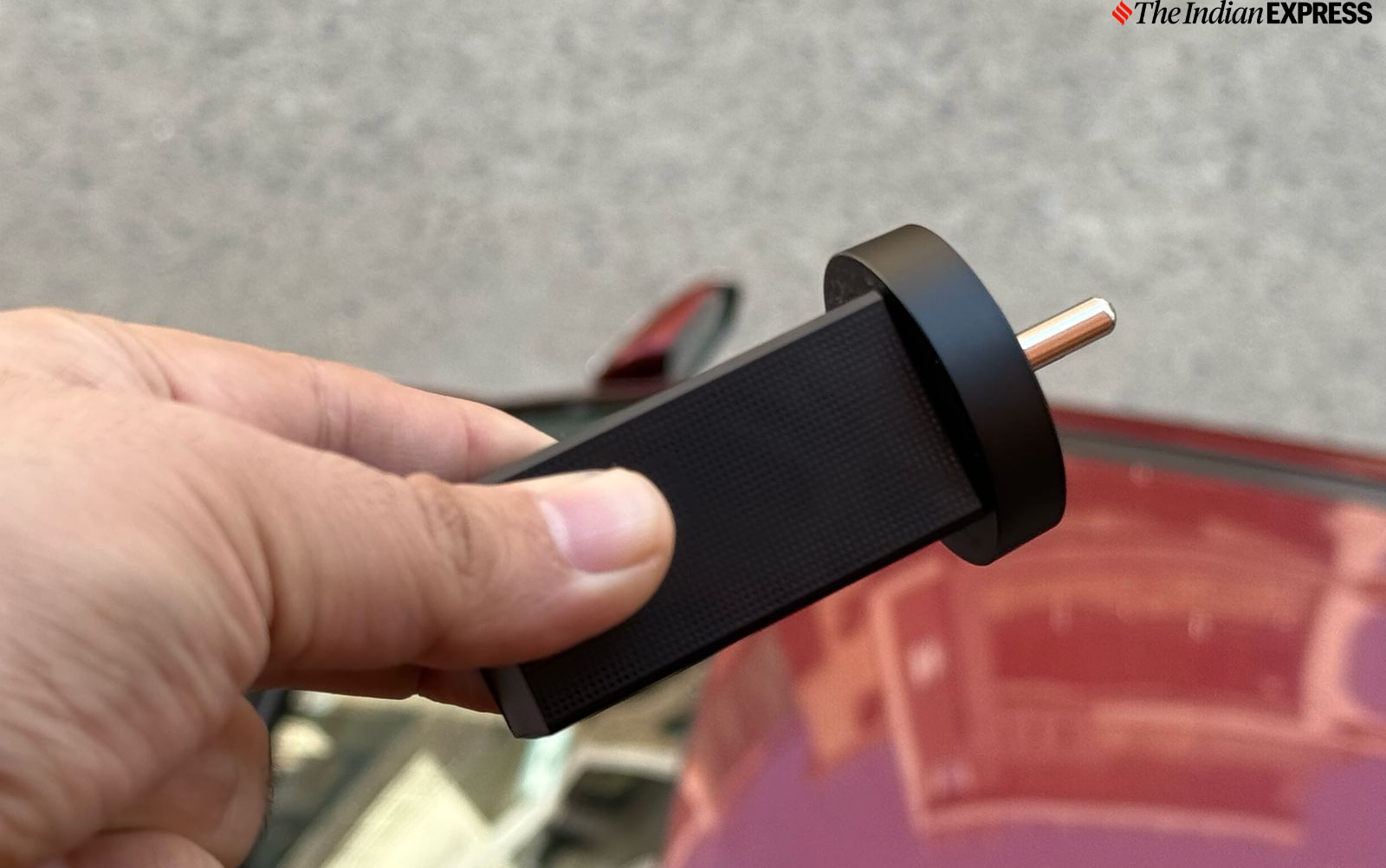 Just look at the charger that comes with the ZenBook A14. (Image credit: Anuj Bhatia/Indian Express)
Just look at the charger that comes with the ZenBook A14. (Image credit: Anuj Bhatia/Indian Express)
At first glance, I thought the laptop was made of plastic. The matte grey finish on my review unit is a departure from the brushed aluminum chassis that most premium notebooks feature. The aesthetics of the ZenBook A14 are very different—almost as if they’re raw and unfinished. That said, it’s a well-built machine, and I can open the lid with one hand.
Even though the ZenBook A14 is lightweight and compact, it still offers most of the connectivity ports I typically need—an HDMI, two USB-C ports, one USB-A port, and a headphone jack. For some, the port selection on this notebook may not be enough, posing a problem if you need to connect a peripheral or a monitor while also charging the battery. For me, though, it works just fine, as I’m either on the go or prefer working from various places rather than just at home. The ZenBook A14 is a mobile laptop—and that’s exactly how it’s designed to be.
Story continues below this ad
I do wish the notebook had built-in 5G connectivity—that would have made it even more useful. I want an always-connected experience on a laptop, and the potential of 5G speeds is huge.
Beautiful OLED display
It’s hard to go back to an LCD/LED display, and I am pretty sure it’s the same for everyone. I was fine using an LED on a laptop a few years ago, but now that I am so used to OLED displays on my smartphone, it’s easy to subconsciously expect screens with vibrant colours and deep blacks.
 I was surprised to see an OLED display on this laptop that costs under a lakh. (Image credit: Anuj Bhatia/Indian Express)
I was surprised to see an OLED display on this laptop that costs under a lakh. (Image credit: Anuj Bhatia/Indian Express)
The ZenBook A14’s OLED screen is beautiful—it’s crisp, clean, has thinner bezels and the overall experience is nice, whether I am watching movies (this is a notebook I can take to bed), working on a presentation, or casually browsing the web. I also found it to be a bright display, making it ideal for working outdoors. I think most people use a laptop not just for productivity but also for content consumption, especially in India, where the idea of a laptop being solely for work may not fully apply. However, I agree that we consume most of our content on phones and tablets far more than on a laptop.
The ZenBook A14, like the MacBook Air, lacks a touchscreen, but I have never found a touch-enabled display particularly useful on a traditional notebook. The Full HD (1080p) webcam is good enough for attending video calls. It also features an IR sensor for Windows Hello logins, though the ZenBook A14 lacks a fingerprint reader. The speakers are decent too, but they are far from the best-sounding speakers on a laptop. Macs simply have better-sounding speakers. Period.
Story continues below this ad
Full-size keyboard and touchpad
Based on my testing, I can say that the keyboard feels much better. I am a keyboard nerd, and from my typing experience on the ZenBook A14, I can tell that the keys have more travel. The spacing between the keys isn’t cramped, and each press feels clicky and snappy. The keyboard is full-sized, although there are no dedicated media control keys in the ZenBook A14’s function row. Writers and journalists will love the ZenBook A14’s keyboard—I can say this with confidence.
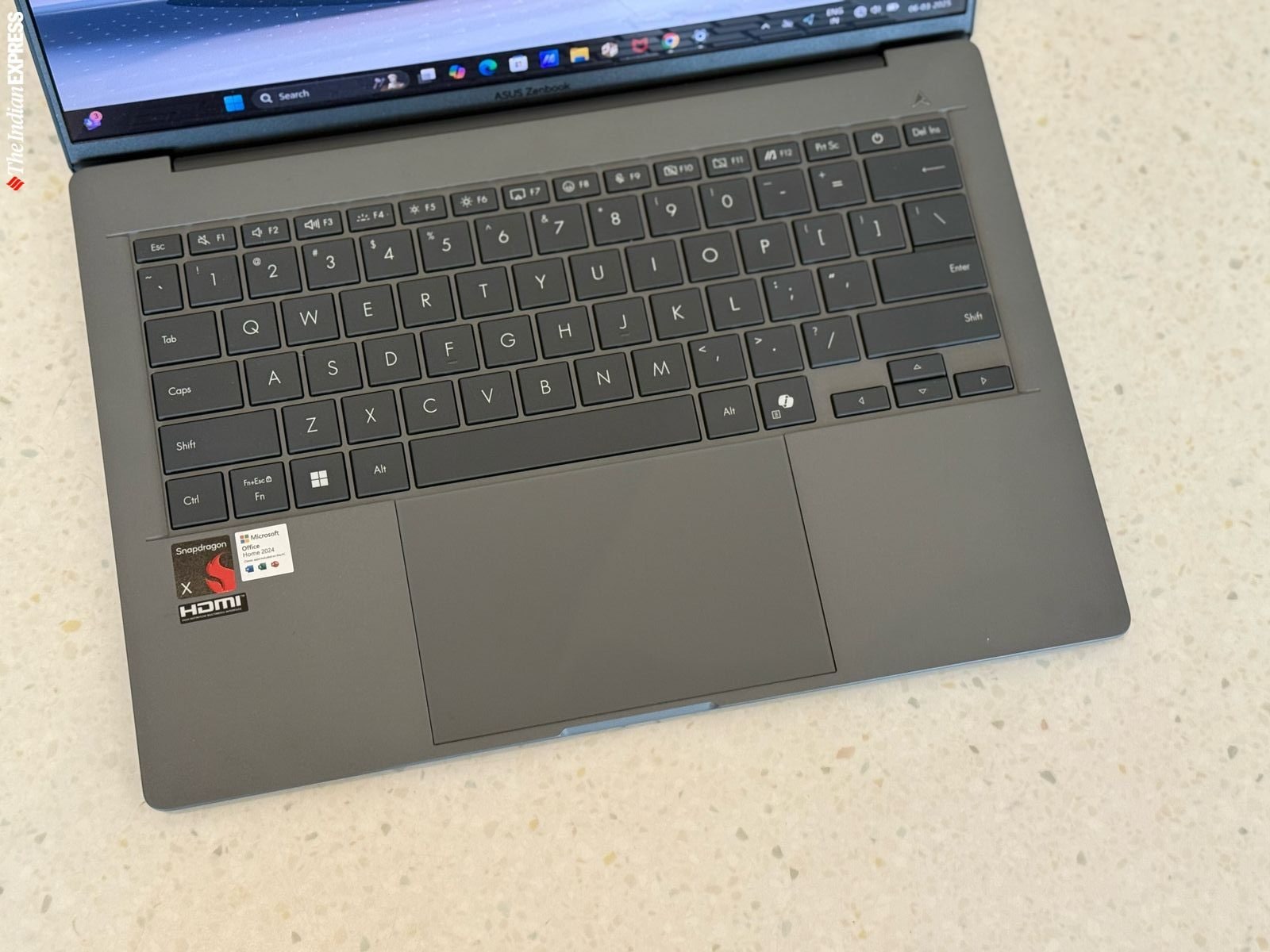 The notebook’s keyboard has large keys with responsive keystrokes. (Image credit: Anuj Bhatia/Indian Express)
The notebook’s keyboard has large keys with responsive keystrokes. (Image credit: Anuj Bhatia/Indian Express)
The touchpad is equally good; it’s large, spacious, and supports smart gestures. That said, I do miss having a haptic touchpad. But at this price point, I might be asking for too much.
A Snapdragon processor does the heavy lifting
If you are wondering whether the ZenBook A14 is powered by an Intel or AMD processor, you are guessing wrong. Instead, the ZenBook A14 is powered by Qualcomm’s new Snapdragon X processor, which recently joined the flagship X Elite and X Plus lineup. This is the third chipset in the Qualcomm Snapdragon X lineup and sits below the X Elite and X Plus series. Essentially, the Snapdragon X is a baseline chip with the same 8-core CPU count as the Snapdragon X Plus processor but runs at a slightly slower clock speed—3GHz versus 3.2GHz—with no boost frequency.
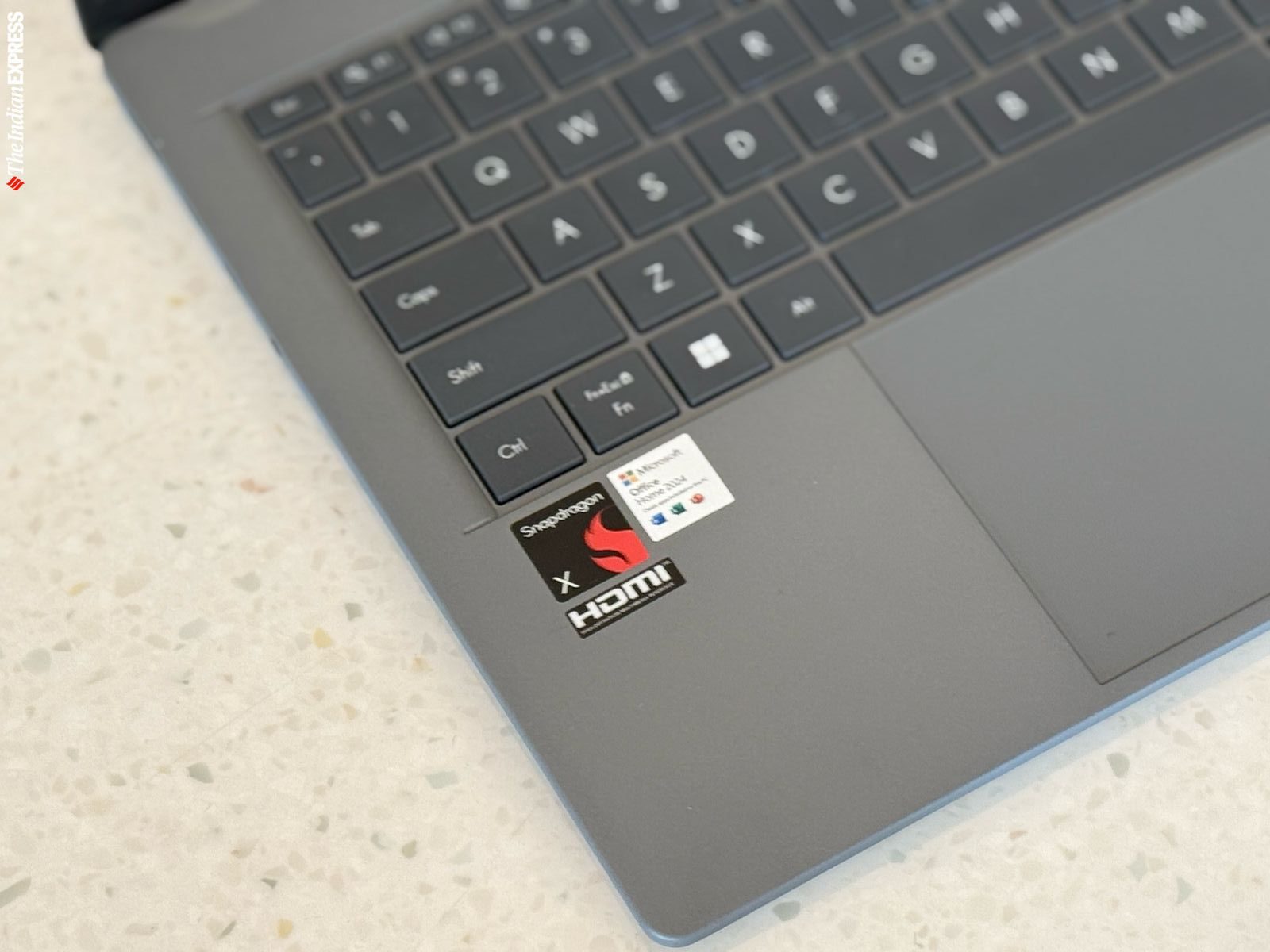 Inside the ZenBook A14 has a processor that’s power efficient, resulting in impressive multi-day battery life. (Image credit: Anuj Bhatia/Indian Express)
Inside the ZenBook A14 has a processor that’s power efficient, resulting in impressive multi-day battery life. (Image credit: Anuj Bhatia/Indian Express)
But let me tell you that these Snapdragon processors are similar to Apple Silicon (M series), meaning they are based on ARM architecture—the same type of processors typically found in smartphones. They are powerful, highly efficient, and offer longer battery life (more on that later).
Story continues below this ad
The big issue with Intel processors is that they are power-hungry and tend to get warm. Sure, Intel still has an edge in high-performance laptops, but most people don’t buy those systems anyway. They want mobile laptops—powerful enough to handle daily computing tasks while offering longer battery life. This is where the ZenBook A14 comes – and Qualcomm really wants to make an impact.
The model I tested had 16GB of RAM, a 512GB SSD, Qualcomm’s integrated Adreno GPU, and the same neural processing unit capable of 45 trillion operations per second, qualifying it as a Copilot Plus PC.
Performance-wise, the ZenBook A14 is fast and handles everyday computing needs with ease. It’s a snappy laptop—apps open quickly. It can handle multiple Chrome tabs, but beyond 20 tabs with Apple Music running in the background, it starts to show the limits of the entry-level Snapdragon X chip. While you can still do light photo and video editing, it’s not primarily designed for those purposes. This notebook won’t satisfy a 3D graphics artist, a professional videographer editing 8K video, or someone doing major color grading on LOG files.
Rather, the ZenBook A14 is for those who need a laptop for writing and editing documents, streaming videos and music, sending emails, and making video calls. For these tasks, the ZenBook A14 performs just fine.
Story continues below this ad
I ran benchmarks using Geekbench 6 and Cinebench 2024, and Qualcomm’s base Snapdragon X processor is a step below the Snapdragon X Elite and X Plus. However, it is definitely not able to beat the latest M series chip from Apple and even Intel’s Lunar Lake series processor.
That being said—and I repeat—these benchmarks do not show the whole picture. It’s subjective, after all. How much “power” is enough for most people? The fact remains that the ZenBook A14 boots quickly, runs cool and silently, and does not get warm.
This is an AI laptop, and the Neural Engine allows it to run on-device LLMs and generative AI apps. If not today, then in the future, almost every app will incorporate artificial intelligence capabilities. Keeping that in mind, the ZenBook A14 is a future-proof device.
However, the big elephant in the room is software compatibility. Windows on Snapdragon-based machines has had issues in the past and the software ecosystem is still evolving. Microsoft is working with Qualcomm to improve app compatibility. And I would say progress has been made.
Story continues below this ad
Big-name ISVs like Adobe are finally offering support, while Office productivity apps like Word, Excel, PowerPoint, and Chrome already natively support Windows on ARM. Regardless, there are undoubtedly some applications and games that will have compatibility issues.
Extremely long battery life
Perhaps the strongest part of the ZenBook A14 is its battery life. Asus claims the ZenBook A14’s battery can last up to 32 hours. In my battery tests, I got 21 hours of battery life. I typically start my day early, around 7 am, and use it constantly throughout the day. It was still going strong at night when I watched a movie. The ZenBook A14 can last almost two full workdays for office use. These numbers are far better than most Intel and AMD-powered laptops and even the M-series MacBook Air. Charging can be done via either of the two USB-C ports.
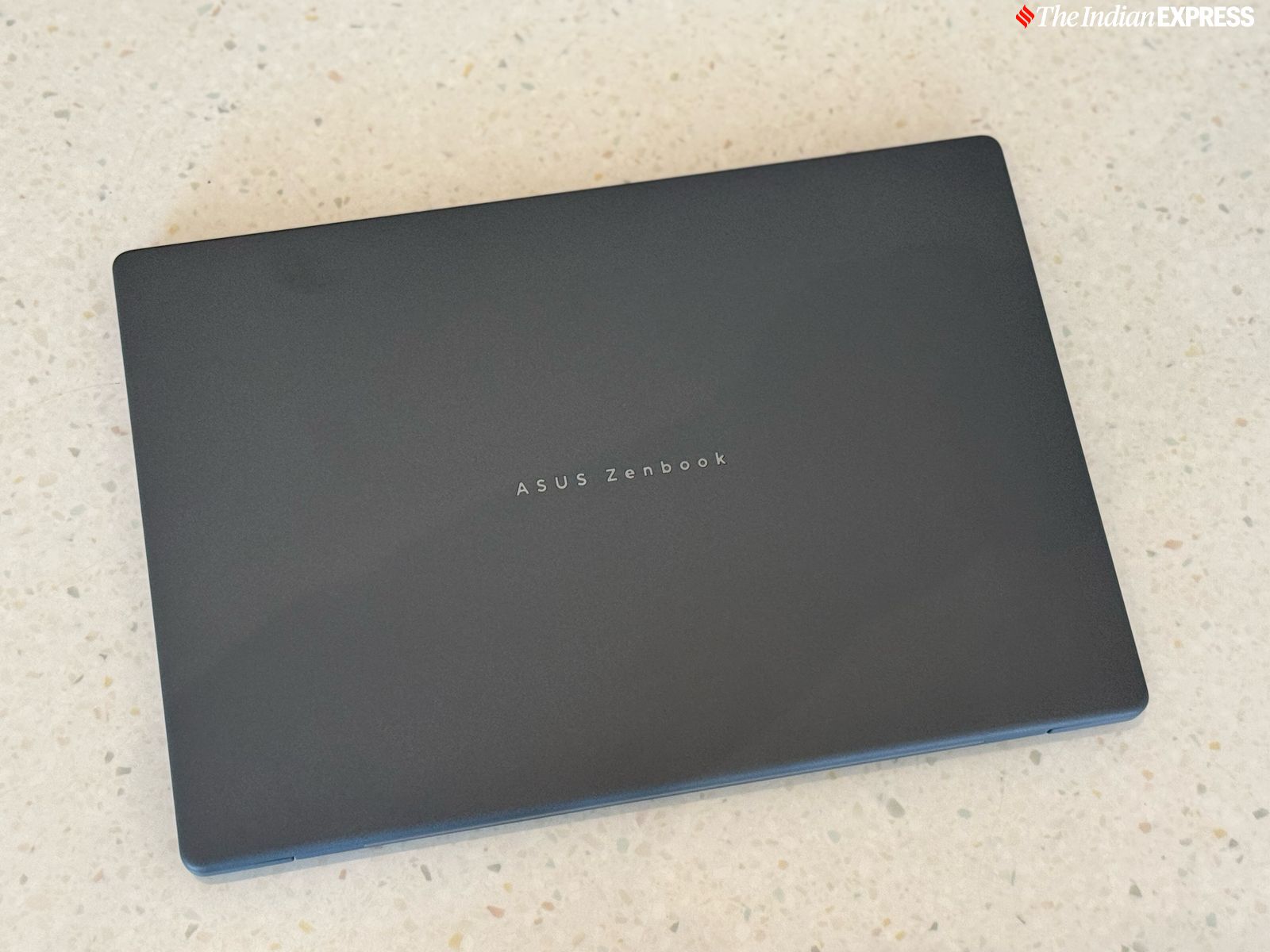 The ZenBook A14 is available only in dark grey colour. (Image credit: Anuj Bhatia/Indian Express)
The ZenBook A14 is available only in dark grey colour. (Image credit: Anuj Bhatia/Indian Express)So who is the Asus ZenBook A14 is for?
It’s for someone who is always on the go, a frequent traveller and user of cloud-based apps like Google Docs. The ZenBook A14 is perfect for users who connect wirelessly and don’t want to be weighed down by a bulky laptop. However, it’s not for those who need a machine for heavy photo and video editing or gaming. Day to day, it is remarkably capable—especially considering what it’s working with. This is a legit Windows PC, and in everyday usage, it runs perfectly. That being said, the ZenBook A14 has its limits, but you won’t find another laptop in this price range that is as light, features an OLED display, and offers such impressive battery life. Of course, there are better laptops on the market—I am not denying that. The new MacBook Air M4 (Starts at Rs 99,900) is also targeting the same demographic as the ZenBook A14, and competition is always good.




